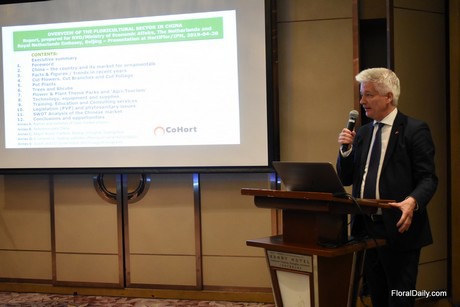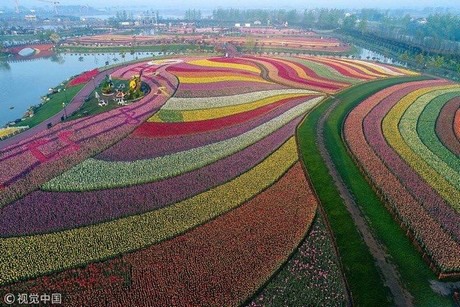At the Hortiflorexpo IPM Shanghai 2019, the 'Overview of the Floricultural Sector in China' report was presented, commissioned by the Dutch embassy in Beijing. The report, an update of a similar study from 2008, provides an overview of the current state of affairs in the Chinese ornamental industry: what's produced where and by whom, what are the major developments in the industry and where is it headed in the coming years? We've listed the main findings below.
In 2016, the total acreage of ornamental cultivation in China was 1.34 million hectares. This acreage is divided into 64,500 hectares of cut flowers, 106,000 hectares of potted plants and 777,000 hectares of trees and shrubs. Over the past two years, there has been marginal growth in this area. All in all, the products fetched 18 billion euros in the domestic wholesale market, and 26 billion euros in retail. Export was a bit more than half a billion euros.
 Oscar Niezen of CoHort presenting the report at the Network cocktail & buffet dinner organized by the Dutch Embassy during the IPM Shanghai.
Oscar Niezen of CoHort presenting the report at the Network cocktail & buffet dinner organized by the Dutch Embassy during the IPM Shanghai.
Production
Although the average Chinese consumer has more to spend, potted plants are popular and cut flowers considered a bit of a luxury item, production lags behind. The report mentions small plots, strong competition with food crops, increasing costs for input and labor, lack of know-how, limited investments in infrastructure and cooling, and perhaps as the most important challenge: protection of plant varieties leaves much to be desired.
The flower production is concentrated in Yunnan and around a few of the larger cities. The focus is on roses, carnations, lilies, gladioli, chrysanthemum and gerbera. The production of potted plants (orchids, bromeliad and anthurium, as well as 'newcomers' like succulents, potted roses, calla and kalanchoe) is more evenly distributed across the country.

The Holland Flower Park, or Dafeng Helan Hua Hai (at the east coast, about 120 miles north of Shanghai)
Communism
Interesting, and 'need to know' for an entrepreneur with plans in China, is the so-called Five Year Plan. In the current, thirteenth Five Year Plan (2016-2020), the government notes that the current production acreage is about as big as it will get, with 30 'mega flower enterprises' to be established within that acreage. Also, the wholesale & retail market is still mostly state-run. That applies to production and purchasing as well. The state is by far the biggest buyer.
Still, these market dynamics offer opportunities for independent entrepreneurs. Because of the mostly outdated infrastructure and a lacklustre cold chain, new investors see opportunities to organize this better themselves. And although sales of flowers and plants are done in a traditional manner - nearly everything goes through the florist, there are hardly any supermarkets or DIY stores - e-commerce is booming and offers opportunities.
Import
In practice, a limited number of products are imported. Bulbs in the first place: around 535 million of them in 2017. Apart from that, cut flowers are an increasingly important import product, on the one hand because roadblocks are taken away by the government, on the other hand because the Dutch are pushing their flowers. This also applies to technique: more and more suppliers with horticultural know-how and tech are opening branch offices in China, and for a good 'Dutch farm manager', local companies are willing to pay.
